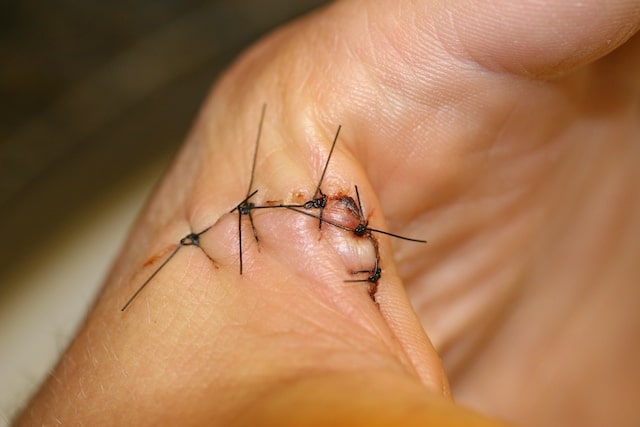Understanding Suture Removal: A Comprehensive Guide
Suture removal is an essential procedure in the healing process after surgery or injury. Sutures, commonly known as stitches, are used to close wounds, incisions, or surgical sites to promote healing and prevent infection. This article aims to provide a detailed understanding of suture removal, including what sutures are, when and how they are removed, the types of sutures, and tips for proper wound care following removal.
What Are Sutures?
Sutures are medical devices used to hold body tissues together after an injury or surgery. They are made from various materials and come in different types, each designed for specific purposes. The primary function of sutures is to facilitate healing by bringing the edges of a wound together, reducing the risk of infection, and minimizing scarring.
Types of Sutures
- Absorbable Sutures: These sutures are designed to be broken down and absorbed by the body over time. They are commonly used for internal stitches or in areas where removal would be difficult. Absorbable sutures eliminate the need for a follow-up visit for removal.
- Non-absorbable Sutures: These sutures remain in the body until they are surgically removed. They are typically used on the skin or in areas subject to tension, where long-term support is necessary.
- Monofilament Sutures: Made from a single strand of material, monofilament sutures are less likely to harbor bacteria and are smoother, making them easier to pass through tissue.
- Multifilament Sutures: These consist of multiple strands twisted together, providing better knot security and flexibility. However, they may have a higher risk of infection due to their textured surface.
Materials Used in Sutures
Sutures can be made from various materials, including:
- Silk: A natural fiber used for non-absorbable sutures, often used in delicate tissues.
- Polypropylene: A synthetic material known for its strength and minimal tissue reaction.
- Polyglycolic Acid: A synthetic absorbable suture that is widely used in surgeries.
- Catgut: A natural absorbable suture made from animal intestines, although its use has declined due to advancements in synthetic materials. For more related articles, visit Healthline Media.
When Is Suture Removal Necessary?
The need for suture removal depends on several factors, including the type of suture used, the location of the wound, and the individual’s healing progress. Generally, sutures are removed when the wound has sufficiently healed, which is typically between 5 to 14 days after placement.
Signs That Sutures Should Be Removed
- Wound Integrity: The edges of the wound should be close together and show no signs of separation.
- Absence of Infection: There should be no redness, swelling, or discharge around the sutured area.
- Formation of Scab: A scab or new skin growth may indicate that the wound is healing well.
The Suture Removal Process
Suture removal is generally a straightforward process that can be done in a healthcare setting or at home with proper guidance. Here’s a detailed overview of the process:
Preparation for Suture Removal
- Gathering Supplies: Ensure you have the necessary tools, including sterile scissors, forceps, antiseptic wipes, and adhesive bandages.
- Cleaning the Area: Wash your hands thoroughly and clean the area around the sutures with antiseptic wipes to minimize the risk of infection.
Steps for Removing Sutures
- Examine the Wound: Before removing sutures, assess the wound for any signs of infection or complications.
- Cutting the Suture: Using sterile scissors, cut the suture close to the skin without cutting the skin itself. For absorbable sutures, this step may not be necessary as they dissolve over time.
- Removing the Suture: Using forceps, gently pull the suture out of the skin. If the suture is stuck, do not force it; instead, cut it again and try again.
- Inspecting the Wound: After all sutures are removed, check the wound for proper healing. Apply an antiseptic if necessary.
- Bandaging the Wound: If the wound is still healing, apply a sterile bandage to protect it from bacteria and further injury.
Post-Suture Removal Care
Proper care after suture removal is crucial to prevent infection and promote healing. Here are some essential tips:
- Keep the Area Clean and Dry: Avoid submerging the area in water for at least 48 hours after removal.
- Monitor for Signs of Infection: Look for increased redness, swelling, or discharge from the wound. If any of these occur, consult a healthcare professional.
- Avoid Strenuous Activities: Limit activities that may strain the wound site to promote healing.
- Moisturize the Area: Apply a suitable moisturizer or ointment to keep the area hydrated, which can help reduce scarring.
Common Concerns About Suture Removal
Pain During Suture Removal
Many individuals are concerned about pain during the suture removal process. While some discomfort is normal, it is usually minimal and brief. If pain is severe, it may indicate that the wound is not healing properly, and you should consult a healthcare professional.
Risk of Infection
Removing sutures carries a small risk of infection. To minimize this risk:
- Always use sterile tools.
- Keep the area clean and dry.
- Avoid touching the wound with dirty hands.
Scarring After Suture Removal
Scarring is a common concern after suture removal. The extent of scarring can depend on various factors, including:
- The type of sutures used.
- The location and size of the wound.
- The individual’s skin type and healing ability.
To minimize scarring, consider using silicone gel sheets or ointments specifically designed for scar prevention.
When to Seek Medical Attention
While suture removal can often be done at home, certain situations warrant a visit to a healthcare professional:
- Signs of Infection: If you notice increased redness, swelling, or discharge from the wound, seek medical attention.
- Severe Pain: Persistent or worsening pain may indicate complications that require medical evaluation.
- Wound Dehiscence: If the wound begins to open or separate, it’s essential to consult a healthcare provider.
Conclusion
Suture removal is a vital part of the healing process following surgery or injury. Understanding what sutures are, how they are removed, and how to care for the wound afterward is crucial for ensuring proper healing and minimizing complications. By following the guidelines outlined in this article, individuals can confidently approach suture removal, whether in a clinical setting or at home.
In summary, remember the following key points about suture removal:
- Types of Sutures: Know the difference between absorbable and non-absorbable sutures.
- Removal Process: Understand the steps involved in safe and effective suture removal.
- Post-Removal Care: Follow proper care guidelines to promote healing and prevent infection.
By being informed about the suture removal process, individuals can take charge of their recovery and enjoy the benefits of effective wound care.

